
New Castle is a city in New Castle County, Delaware, United States, six miles (10 km) south of Wilmington, and situated on the Delaware River. According to the 2010 Census, the population of the city is 5,285.

Brandywine Creek is a tributary of the Christina River in southeastern Pennsylvania and northern Delaware in the United States. The Lower Brandywine is 20.4 miles (32.8 km) long and is a designated Pennsylvania Scenic River with several tributary streams. The East Branch and West Branch of the creek originate within 2 miles (3 km) of each other on the slopes of Welsh Mountain in Honey Brook Township, Pennsylvania, about 20 miles (32 km) northwest of their confluence.
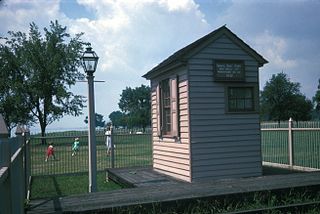
The New Castle and Frenchtown Turnpike and Rail Road (NC&F) was opened in 1831, was the first railroad in Delaware and one of the first in the United States. About half of the route was abandoned in 1859; the rest became part of the Pennsylvania Railroad (PRR) route into the Delmarva Peninsula and is still used by Norfolk Southern Railway. The abandoned segment from Porter, Delaware, to Frenchtown, Maryland, the New Castle and Frenchtown Railroad Right-of-Way, was listed on the National Register of Historic Places in 1976.

Buildings, sites, districts, and objects in Delaware listed on the National Register of Historic Places:
This is a list of properties on the National Register of Historic Places in northern New Castle County, Delaware.

Stonum, also called Stoneham, is a historic house at 900 Washington Avenue in New Castle, Delaware. Its main section built about 1750, it was the country home of George Read (1733-1798), a signer of the Declaration of Independence. His advocacy enabled Delaware to become the first state ratifying the declaration. The house was declared a National Historic Landmark in 1973. It is the only building standing associated with this Founding Father.
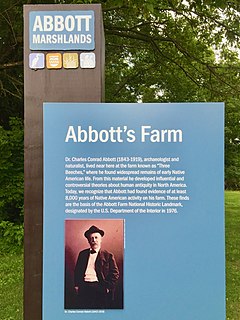
The Abbott Farm Historic District is a National Historic Landmark archaeological site in New Jersey. It is the largest known Middle Woodland village of its type on the East Coast of the United States. Significant evidence suggests that the Delaware River floodplain was occupied by Paleoindian people for a long period. It was inhabited between 500 BC and 500 AD. It has been a source of controversy and debate around early development.
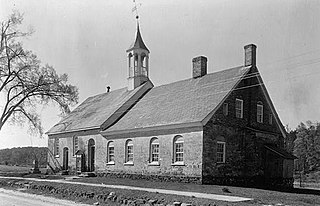
Bethabara Historic District encompasses the surviving buildings and archaeological remains of a small Moravian community, that was first settled in 1753. Located in present-day Forsyth County, North Carolina, it is now a public park of the city of Winston-Salem. It was designated National Historic Landmark in 1999.

Kirkwood is an unincorporated community in central New Castle County, Delaware, United States. It lies along Delaware Route 71, southwest of the city of Wilmington, the county seat of New Castle County. Its elevation is 69 feet (21 m). It has a post office with the ZIP code 19708.
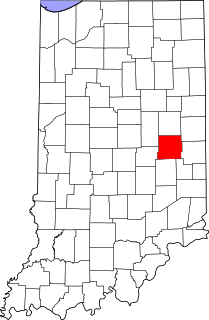
This is a list of the National Register of Historic Places listings in Henry County, Indiana.
Stanton is an unincorporated community in New Castle County, Delaware, United States, near the confluence of the Red Clay and White Clay Creeks. It is located in the southern end of Mill Creek Hundred.
This is a list of the National Register of Historic Places listings in southern New Castle County, Delaware.
Biddles Corner is a location in St. George's Hundred, New Castle County, Delaware, United States.

Greenbank Historic Area is a historic grist mill located at Marshallton, New Castle County, Delaware. The property includes the Greenbank Mill, Robert Philips House, and the W. G. Philips House. The mill was built in 1790 and expanded in 1812. It is a 2+1⁄2 story, frame structure with a stone wing. The mill measures 50 feet (15 m) by 39 feet (12 m). The Robert Philips House was built in 1783, and is a 2+1⁄2 story, five bay, stone dwelling with a gable roof. The front facade features a long verandah. The W. G. Philips House, also known as the mill owner's house, dates to the mid-19th century. It consists of a two-story, three bay front section with a three-story, hipped roof rear section. Oliver Evans, a native of nearby Newport, installed his automatic mill machinery in the 1790 building.

Duncan Beard Site, also known as the Duncan Beard's House and Shop, is an archaeological site located near Odessa, New Castle County, Delaware. It was the site of the house and shop of a Delaware lock-maker of great distinction and silversmith. He lived and labored here for about 30 years until his death in 1797. He was a prominent member of Old Drawyers Presbyterian Church and made a contract with State of Delaware in 1776 for the manufacture of gun locks.
The Thompson's Loss and Gain Site is a colonial-era historic site near Rehoboth Beach in Sussex County, Delaware. It is an archaeological site encompassing a tenant farm that was in active use from about 1720 to 1780. The site includes the site of a house, root cellar, and well. It was listed on the National Register of Historic Places in 1978.
The Hell Island Site (7NC-F-7) is a prehistoric archaeological site located near Odessa, Delaware. The site is a type site for a class of ceramics found at other sites in the region. Artifacts recovered from the site during excavations in 1965 yielded then-distinctive tempered pottery with cordmarking on the interior and exterior, as well as evidence of occupation of the site from the Archaic to the Late Woodland Period.
The Dill Farm Site (7K-E-12) is a prehistoric archaeological site in Kent County, Delaware, near the town of Sandtown. The site located in a formerly swampy area, has yielded dates of 500 BC and 8000 BC. Carey Complex ceramics have also been found at the 55-acre (22 ha) site.
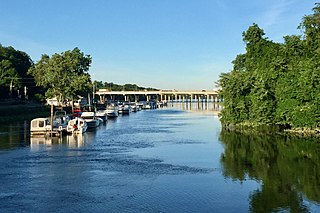
The Crosswicks Creek Site III is a historical archaeological site in the vicinity of Bordentown in Burlington County and Hamilton Township in Mercer County, New Jersey. It encompasses the remains of Revolutionary War-era ships that were sunk in Crosswicks Creek in 1778. The site was listed on the National Register of Historic Places on November 26, 1990 for its significance in military and maritime history.














